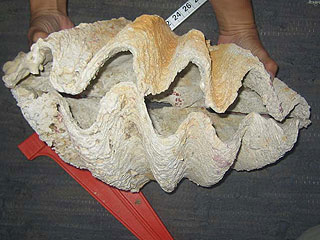
August 28, 2008

A new species of giant clam, Tridacna costata, has been discovered in the Red Sea.
These giant two feet long clams might have helped feed prehistoric humans as they first migrated out of Africa.
Tridacna costata once accounted for more than 80 percent of giant clams in the Red Sea. Today, these mollusks, the first new living species of giant clam found in two decades, represent less than 1 percent of giant clams living there.
This novel clam, whose shell has a distinctive scalloped edge, was discovered while scientists were attempting to develop a breeding program for another giant clam species, Tridacna maxima, which is prized in the aquarium trade. The new species appears to live only in the shallowest waters, which makes it particularly vulnerable to overfishing.
“These are all strong indications that T. costata may be the earliest example of marine overexploitation,” said researcher Claudio Richter, a marine ecologist at the Alfred-Wegener-Institute for Polar and Marine Research in Bremerhaven, Germany.
No one had expected to discover a new giant clam species, “particularly in the Red Sea, one of the best investigated coral reef provinces,” Richter said. The fact that it was overlooked for so long “is a testimony as to how little we really know about marine biodiversity.”
Only six out of 1,000 live specimens the scientists observed belonged to the new species.
The scientists detailed their findings online on Aug. 28 in the journal Current Biology.
For more, see LiveScience.
About Loren Coleman
Loren Coleman is one of the world’s leading cryptozoologists, some say “the” leading living cryptozoologist. Certainly, he is acknowledged as the current living American researcher and writer who has most popularized cryptozoology in the late 20th and early 21st centuries.
Starting his fieldwork and investigations in 1960, after traveling and trekking extensively in pursuit of cryptozoological mysteries, Coleman began writing to share his experiences in 1969. An honorary member of Ivan T. Sanderson’s Society for the Investigation of the Unexplained in the 1970s, Coleman has been bestowed with similar honorary memberships of the North Idaho College Cryptozoology Club in 1983, and in subsequent years, that of the British Columbia Scientific Cryptozoology Club, CryptoSafari International, and other international organizations. He was also a Life Member and Benefactor of the International Society of Cryptozoology (now-defunct).
Loren Coleman’s daily blog, as a member of the Cryptomundo Team, served as an ongoing avenue of communication for the ever-growing body of cryptozoo news from 2005 through 2013. He returned as an infrequent contributor beginning Halloween week of 2015.
Coleman is the founder in 2003, and current director of the International Cryptozoology Museum in Portland, Maine.
Filed under Breaking News, Cryptotourism, CryptoZoo News, Cryptozoology, New Species